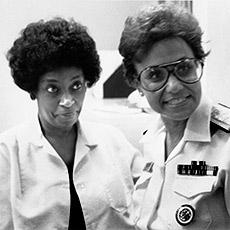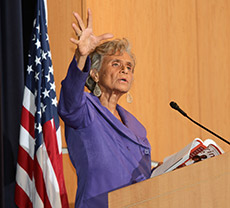Marilyn Gaston, MD, still a frontline fighter against sickle cell disease
On October 17, faculty and staff from Cincinnati Children’s and the University of Cincinnati gathered to honor Marilyn Gaston, MD, a community pediatrician who published a landmark study 30 years ago in the New England Journal of Medicine proving the effectiveness of penicillin in extending the lives of children with sickle cell disease. The celebration included a morning symposium outlining the past, present and future status of sickle cell research and treatment in the Sabin Auditorium, followed by a luncheon at the Kingsgate Marriott.
At 77, Gaston is a petite ball of fire who clearly hasn’t lost her passion for helping children – or for enjoying life. She graduated from Walnut Hills High School, attended Miami University, then earned her MD from the UC College of Medicine and completed her residency at Cincinnati Children’s.
Says Bea Lampkin, MD, former director and founder of Hematology/Oncology, “I had the pleasure of being one of Marilyn’s teachers. It was evident to me then that she would have an outstanding career.”
During her internship, Gaston became interested and passionate about sickle cell disease. “I was working in the ED when a little kid came in with a swollen hand,” she recalls. “I suspected abuse and decided to admit the child. Of course, this put the parents under suspicion.
“A second-year resident told me to take a look at the child’s blood smear. I did. It was sickle cell. I felt so terrible that I had made the wrong call. I wanted to learn everything I could then about sickle cell disease.”
Gaston went into private practice at the Lincoln Heights Health Center, where she saw more patients with sickle cell. They were depressed. They felt isolated. Gaston brought all the patients and families together to educate them about the disease. She also educated the doctors in the ED. “I wanted more attention paid to the disease,” she says, “and to accomplish that, we needed money.”
In 1973, Gaston, with the help of Cathryn Buford, co-founder of the Sickle Cell Awareness Group, and Alvin Mauer, MD, director, Hematology, applied for an NIH grant to establish the Comprehensive Sickle Cell Center at Cincinnati Children’s. It was one of the first 10 sickle cell centers the NIH funded in the US.
Prior to the center’s opening, children with sickle cell disease were seen in Hematology. But they received no special attention. The center, with its focus on treatment, education, testing and counseling, research and training of allied personnel, greatly improved the quality of care for these patients and families.
Gaston’s biggest contributions to the fight against sickle cell disease are:
- Her program to evaluate cord blood to detect sickle cell disease in infants. Early detection was the key to survival, since many babies with sickle cell disease are prone to contracting overwhelming bacterial infections, leading to rapid and often fatal septic shock. Gaston pushed for mandatory screening for sickle cell disease and sickle cell trait.
- The double-blind study she conducted in which she gave one group of patients with sickle cell 125 mgs of oral penicillin daily as a prophylactic, compared to a control group, which received a placebo. There were three deaths in the placebo group and none in the study group. The study group also saw an 85-percent reduction of pneumococcus-related complications. This was the study Gaston published in the New England Journal of Medicine that changed the trajectory of the disease and helped push the expected lifespan of these patients from 19 years of age to 40+ years.
Gaston has distinguished herself as the first African American woman to direct a Public Health Service bureau. She also served as Assistant Surgeon General and Rear Admiral in the US Public Health Service. But even as she received several standing ovations from those who attended the symposium, she was quick to share the praise.
“Nobody does anything by themselves,” she said. “All of the training I received right here at home prepared me for the challenges I faced. And all of the things I’ve accomplished are because of the help I received from everyone else. We can’t lose sight of the importance of what patients and families teach us. And please, don’t lose sight of how important you are to the work we still have to do.”





